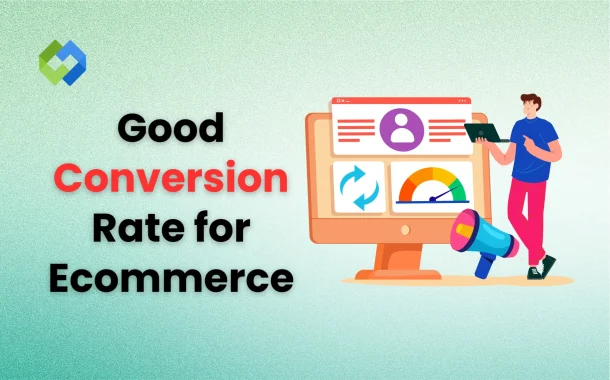A good conversion rate is crucial for ecommerce businesses. It shows how effectively your site is converting visitors into buyers. Higher conversion rates usually mean better sales and more revenue. By tracking and improving your conversion rate, you can make your marketing efforts more efficient and boost your profits.
Table of Contents
Table of Contents
What is Conversion Rate and How It’s Calculated
A conversion rate is a key performance indicator that measures the effectiveness of a website in persuading visitors to take a specific action. These actions, known as conversions, can vary depending on the goals of the website. Common conversions include making a purchase, signing up for a newsletter, downloading a resource, or filling out a contact form.
In essence, the conversion rate reflects how well your site fulfills its purpose, whether it’s driving sales, generating leads, or encouraging other types of user engagement. A higher conversion rate typically indicates that the site is more effective at convincing visitors to complete the desired action.
Calculating the conversion rate is straightforward but critical for understanding your website’s performance. First, determine the number of conversions, such as the number of purchases made or forms submitted during a specific period. Next, divide this number by the total number of visitors to your site during the same period. Finally, multiply the result by 100 to get the conversion rate as a percentage. For example, if 200 people visit your site and 10 make a purchase, the calculation would be: (10 conversions / 200 visitors) * 100 = 5% conversion rate.
Benchmarking Conversion Rates
Benchmarking conversion rates involves comparing your website’s conversion performance against industry standards or competitors. It helps you understand how your site is performing relative to others in your market. Industry averages can vary widely depending on factors like product type, target audience, and marketing channels. For example, ecommerce sites might see average conversion rates ranging from 1% to 4%, while lead generation sites could experience higher rates due to different goals.
Benchmarking allows you to set realistic expectations and identify areas where your website may be underperforming. By comparing your conversion rate to industry averages, you can assess whether your site is competitive or needs improvement. It also helps in setting specific, achievable goals for optimization. Regularly benchmarking your conversion rates ensures that you stay aligned with market trends and continue to optimize your site for better performance.
Setting Goals and Targets
Setting goals and targets for your conversion rate is essential for driving business growth. These goals should be realistic and based on your current performance and industry benchmarks. Start by analyzing your existing conversion rate to understand where you stand. Then, consider factors like your business objectives, marketing strategies, and customer behavior to set achievable targets. For example, if your current conversion rate is 2%, a reasonable goal might be to increase it to 2.5% over the next six months.
Clear and measurable goals give your team a focus and direction. They help in prioritizing tasks and allocating resources effectively. Aligning your conversion rate targets with broader business goals ensures that your efforts contribute directly to overall success. Regularly review and adjust your goals as needed, based on performance data and market changes. This ongoing process helps keep your conversion rate optimization efforts on track and moving toward success.
Improving Your Conversion Rate
Improving your conversion rate is crucial for maximizing the effectiveness of your website. Start by optimizing your site’s design and user experience. Ensure that your website is easy to navigate, loads quickly, and is mobile-friendly. A well-designed website keeps visitors engaged and makes it easier for them to complete a desired action, like making a purchase or signing up for a newsletter.
Next, focus on enhancing your content and calls-to-action (CTAs). Your content should be clear, compelling, and relevant to your audience. Strong CTAs, like “Buy Now” or “Sign Up Today,” should be prominently placed and encourage immediate action. Additionally, building trust through customer reviews, testimonials, and security badges can boost conversions by making visitors feel more confident in their decision.
Using A/B testing to experiment with different elements of your site, such as headlines, images, or CTA buttons. Testing allows you to see what works best for your audience and make data-driven improvements. By continuously refining your site based on user behavior and feedback, you can steadily increase your conversion rate and achieve better business results.
Tools and Techniques for Tracking
1. Analytics Tools for Conversion Tracking
Analytics tools are the foundation of conversion tracking, providing essential data on how visitors interact with your website. Google Analytics is one of the most widely used tools, offering features that allow you to set up specific goals, track conversions, and analyze visitor behavior.
You can see where your traffic is coming from, how users navigate through your site, and where they drop off. This data helps you understand the effectiveness of your marketing efforts and identify areas for improvement. Other tools, like Adobe Analytics, offer advanced features for larger businesses that need more in-depth analysis.
2. Heatmaps and Session Recordings
Heatmaps and session recording tools, such as Hotjar and Crazy Egg, offer visual insights into user behavior. Heatmaps show where users click, scroll, and spend the most time on your site. This information helps you identify which parts of your pages are engaging visitors and which are being ignored.
Session recordings take this a step further by allowing you to watch real-time interactions as users navigate your site. By analyzing these recordings, you can pinpoint usability issues, confusing navigation, or any barriers that might be preventing conversions. This visual data is invaluable for making targeted improvements to your site’s design and layout.
3. A/B Testing and Experimentation
A/B testing is a powerful technique for improving your conversion rate by experimenting with different versions of your web pages. Tools like Optimizely, VWO, and Google Optimize allow you to create multiple variations of a page element such as headlines, images, or call-to-action buttons and test them against each other.
For instance, you might test two different headlines to see which one drives more clicks or purchases. The tool then tracks the performance of each variation and identifies the one that leads to higher conversions. This method enables you to make data-driven decisions and continuously optimize your website for better results.
4. Conversion Funnel Analysis
Understanding the conversion funnel is crucial for identifying where potential customers are dropping off. Tools like Google Analytics and Mixpanel offer conversion funnel analysis features that allow you to map out the steps users take from the moment they land on your site to when they complete a conversion.
By analyzing this funnel, you can see at which stage users are most likely to abandon the process and why. For example, if many users drop off during the checkout process, you might need to streamline that experience. Funnel analysis helps you focus your optimization efforts on the areas that will have the most significant impact on your conversion rate.
FAQs
Q1. What is considered a good conversion rate for a new ecommerce site?
A good conversion rate for a new ecommerce site typically ranges from 1% to 2%. As the site gains more traffic and trust, this rate can improve with optimization efforts and better marketing strategies.
Q2. How does mobile traffic affect conversion rates?
Mobile traffic often has lower conversion rates compared to desktop traffic. This is because mobile users may browse casually, and smaller screens can make the checkout process more challenging. Optimizing your site for mobile can help improve these rates.
Q3. Does the price of products impact conversion rates?
Yes, product pricing significantly impacts conversion rates. Higher-priced items generally have lower conversion rates because customers take longer to decide. Offering discounts, payment plans, or detailed product information can help improve conversions for expensive items.
Q4. How do seasonal trends influence conversion rates?
Seasonal trends, like holiday shopping or back-to-school sales, can cause fluctuations in conversion rates. During peak shopping times, conversion rates typically increase. It’s important to align your marketing efforts with these trends to maximize sales.
Q5. Can improving site speed increase conversion rates?
Yes, faster site speed can lead to higher conversion rates. Slow-loading pages frustrate visitors, causing them to leave before completing a purchase. Optimizing your site’s performance ensures a smoother user experience, which can boost conversions.
Conclusion
What makes a good conversion rate for ecommerce is key to growing your online business. While average conversion rates vary by industry, aiming for a rate between 2% to 3% is a good starting point. However, the best conversion rate is one that aligns with your business goals and reflects continuous improvement.
To achieve a good conversion rate, focus on optimizing your website, enhancing user experience, and regularly testing different strategies. Keep an eye on industry benchmarks, but remember that the most important comparison is your own progress over time. By tracking your conversion rate and making data-driven adjustments, you can improve your site’s performance and increase your sales.














